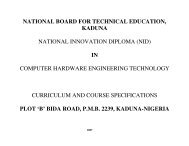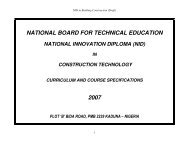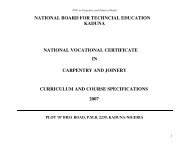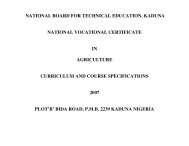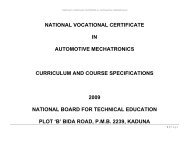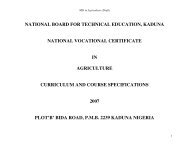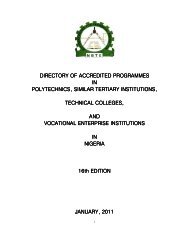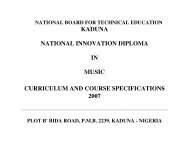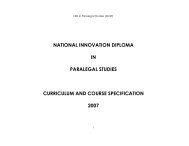COMPUTER SOFTWARE ENGINEERING - NBTE
COMPUTER SOFTWARE ENGINEERING - NBTE
COMPUTER SOFTWARE ENGINEERING - NBTE
You also want an ePaper? Increase the reach of your titles
YUMPU automatically turns print PDFs into web optimized ePapers that Google loves.
fffffff<br />
NID in Software Engineering (Draft)<br />
)<br />
cartridge, bubble, hard<br />
disk, CD-ROM, floppy<br />
disks, zip disk, tape<br />
streamer, flash<br />
memory, optical disk.<br />
can be opened for<br />
demonstration.<br />
Describe the nature and<br />
characteristics of media<br />
listed above<br />
Describe optical<br />
storage device.<br />
GENERAL OBJECTIVE 4: UNDERSTAND DIFFERENT FILE ACCESS METHODS AND THE BUFFERING TECHNIQUES.<br />
TO:<br />
A flip chart,<br />
• Write simple programs<br />
involving sequential and<br />
A white board,<br />
random access methods.<br />
Week<br />
9 – 10 4.1 Differentiate file access<br />
types: - random access<br />
and direct access storage<br />
methods.<br />
4.2 Seek time and rotational<br />
delay<br />
4.3 Explain The concept of a<br />
buffer and its functions<br />
4.4 Describe the calculation of<br />
buffer requirement of a<br />
file.<br />
State different file<br />
access types:- random<br />
access and direct<br />
access storage<br />
methods.<br />
Define seek time and<br />
rotational delay<br />
Explain the parameters<br />
above in relation to<br />
different access<br />
methods mentioned<br />
above.<br />
OHP connected to PC<br />
loaded with appropriate<br />
software.<br />
A PC with most input<br />
and output devices that<br />
can be opened for<br />
demonstration.<br />
To assist students to write<br />
simple programs involving<br />
sequential and random<br />
access methods.<br />
OHP connected to PC<br />
loaded with<br />
appropriate software<br />
in a networked<br />
laboratory.<br />
A PC with most input<br />
and output devices<br />
that can be opened<br />
for demonstration.<br />
Define a buffer<br />
List the functions of a<br />
buffer<br />
Calculate buffer<br />
requirement of a file.<br />
36



